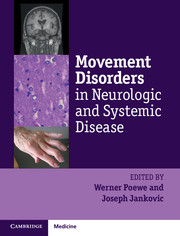Book contents
- Frontmatter
- Contents
- List of contributors
- List of videos
- List of abbreviations
- Preface
- Section I General principles
- Section II Movement disorders in systemic disease
- Chapter 4 Paraneoplastic movement disorders
- Chapter 5 Movement disorders of autoimmune origin
- Chapter 6 Movement disorders in systemic infections
- Chapter 7 Movement disorders in HIV- and AIDS-related central nervous system infections
- Chapter 8 Movement disorders in metabolic diseases in adulthood
- Chapter 9 Movement disorders in childhood metabolic diseases
- Chapter 10 Movement disorders in endocrinological diseases
- Chapter 11 Movement disorders in liver disease
- Chapter 12 Movement disorders in renal diseases
- Chapter 13 Movement disorders in hematological disease
- Section III Iatrogenic and toxic movement disorders
- Section IV Movement disorders in general neurology
- Section V Systemic complications of movement disorders
- Index
- Plate Section
- References
Chapter 6 - Movement disorders in systemic infections
from Section II - Movement disorders in systemic disease
Published online by Cambridge University Press: 05 April 2014
- Frontmatter
- Contents
- List of contributors
- List of videos
- List of abbreviations
- Preface
- Section I General principles
- Section II Movement disorders in systemic disease
- Chapter 4 Paraneoplastic movement disorders
- Chapter 5 Movement disorders of autoimmune origin
- Chapter 6 Movement disorders in systemic infections
- Chapter 7 Movement disorders in HIV- and AIDS-related central nervous system infections
- Chapter 8 Movement disorders in metabolic diseases in adulthood
- Chapter 9 Movement disorders in childhood metabolic diseases
- Chapter 10 Movement disorders in endocrinological diseases
- Chapter 11 Movement disorders in liver disease
- Chapter 12 Movement disorders in renal diseases
- Chapter 13 Movement disorders in hematological disease
- Section III Iatrogenic and toxic movement disorders
- Section IV Movement disorders in general neurology
- Section V Systemic complications of movement disorders
- Index
- Plate Section
- References
Summary
Introduction
The aim of this chapter is to describe movement disorders associated with infections that do not involve invasion of the central nervous system (CNS) by the etiologic agent. The prototype of condition where a systemic infection causes a movement disorder is rheumatic fever (RF). Already in the seventeenth century in England, Thomas Sydenham provided a detailed clinical description which would be named after him. However, its causal relationship with streptococcal infection was only firmly established in the middle of the twentieth century (Taranta and Stollerman 1956). The incidence of Sydenham’s chorea (SC) has markedly decreased in North America and Western Europe since 1960. Nevertheless, it remains the most common of acute choreas in children worldwide. Interest in this condition has been fueled by the hypothesis that Streptococcus-induced antibodies targeted at basal ganglia neurons might account for tics and behavioral abnormalities among children (Cardoso 2002a). In the last two decades of the twentieth century, acquired immune deficiency syndrome (AIDS) was the infectious disease to receive the largest scientific and public attention. Soon after its discovery, movement disorders became recognized among the neurologic complications in patients with AIDS due to the HIV virus (Nath et al. 1987; Brew 2001). The introduction of highly active antiretroviral therapy has led to a remarkable decline in the frequency of occurrence of HIV-related neurologic disorders (Maschke et al. 2000; Cardoso 2002b). Table 6.1 summarizes the most common movement disorders associated with infectious agents.
- Type
- Chapter
- Information
- Movement Disorders in Neurologic and Systemic Disease , pp. 73 - 88Publisher: Cambridge University PressPrint publication year: 2014

